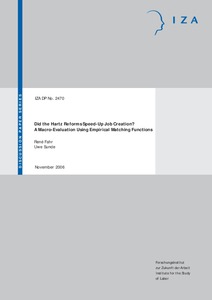Did the Hartz reforms speed-up job creation? A macro-evaluation using empirical matching functions
"Starting in January 2003, Germany implemented the first two so-called Hartz reforms, followed by the third and fourth packages of Hartz reforms in January 2004 and January 2005, respectively. The aim of these reforms was to accelerate labor market flows and reduce unemployment duration. Withou...
| Main Authors: | , |
|---|---|
| Institution: | ETUI-European Trade Union Institute |
| Format: | TEXT |
| Language: | English |
| Published: |
Bonn
2006
IZA |
| Subjects: | |
| Online Access: | https://www.labourline.org/KENTIKA-19293957124910111399-Did-the-Hartz-reforms-speed-up.htm |
| Summary: | "Starting in January 2003, Germany implemented the first two so-called Hartz reforms, followed by the third and fourth packages of Hartz reforms in January 2004 and January 2005, respectively. The aim of these reforms was to accelerate labor market flows and reduce unemployment duration. Without attempting to evaluate the specific components of these Hartz reforms, this paper provides a first attempt to evaluate the overall effectiveness of the first two reform waves, Hartz I/II and III, in speeding up the matching process between unemployed and vacant jobs. The analysis is conceptually rooted in the flow-based view underlying the reforms, estimating the structural features of the matching process. The results indicate that the reforms indeed had an impact in making the labor market more dynamic and accelerating the matching process." |
|---|---|
| Physical Description: | 34 p. Digital |

